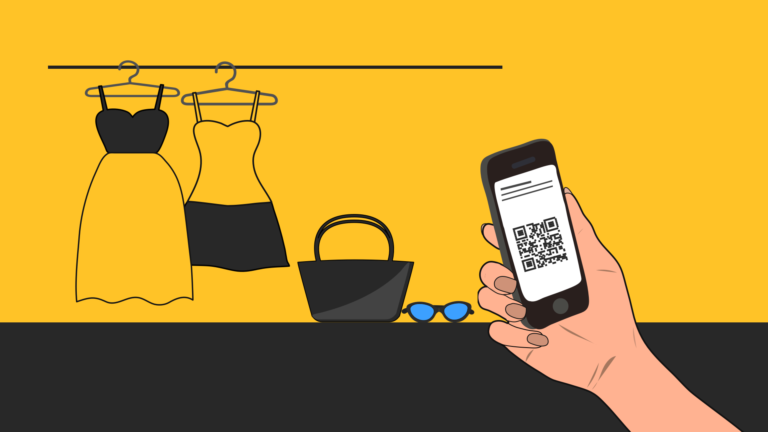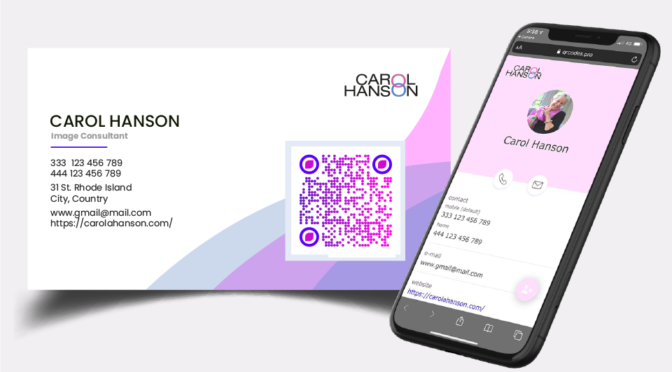QR codes are re-emerging in the eCommerce world and are now a mobile commerce mechanism powered by mobile devices on Android or iOS platforms.
As long as your phone has a native camera app, you can just scan the code and it’ll read the information encoded therein.

Table of Contents
- Why QR Codes are a perfect fit for eCommerce
- How eCommerce is using QR Codes to bring customers back
- 7 creative ways eCommerce is leveraging QR Codes to bring back customers
- Final Thoughts
You might like: How to scan QR Codes on Android and iOS
Perhaps the most recent way they’re coming back to eCommerce is the Shopcodes by Shopify.
Consumers need only scan the code and they’re directed to a product in a Shopify clothing store. They also help eCommerce store owners get more traffic to their sites.
Such codes are generated from an app or a website that’s free and you’ll find these QR Codes in advertisements, product packaging, and smartphone apps.
Although they didn’t quite take off as expected for mainstream use in America, countries like India and China took them up and used QR code-based mobile payment, almost displacing the cash system entirely.
However, they’re gaining importance once again in America thanks to giant mainstream brands like Pepsi, Snapchat, Walmart, Spotify, and others, who are finding good ways to use the codes.
You might like: 11 Best Use Cases of QR Codes
Why QR codes are a perfect fit for eCommerce
eCommerce businesses are using QR codes today in convenience-oriented and commercial tracking applications targeting smartphone users and other WiFi-enabled device users.
Some of the popular ways that they’re used include sending messages or emails, saving contact information, opening up a webpage and more.
You’ll even find them on email signatures, business gatherings, or in-store product examples.
You might like: 7 ways Amazon is using QR Codes and absolutely crushing it
The eCommerce industry has long relied on the CNP or card-not-present method of payment that directs consumers to enter credit card details and security codes before buying items.
How to start an e-commerce store
This comes with more risks as merchants store the customers’ details online, which could be devastating in the event of data breaches.
With QR codes though, the purchasing experience for customers and merchants is improving, as consumers can make payments simply without the merchant getting customer data or sensitive information.
AI solutions for e-commerce can also enhance this process by providing personalized recommendations and cross-selling based on customer behavior in real time.
This way, the transaction is faster, more secure and simplified. Consumers can hold their mobile devices to scan and read the code using a payment app and initiate payments without entering credit card details.
In August 2017, the global technical body – EMVCO – that manages EMV specifications, released the consumer-presented and merchant-presented QR code payment specifications that are free to use.
A good example of the merchant-presented QR codes can be found in all Walmart stores.
Consumers just use their mobile devices to scan the code on the checkout screen and pay for goods using the payment method in the Walmart Pay app.
How eCommerce is using QR codes to bring back users
Smartphone owners are increasing by the day if statistics from the US and UK are anything to go by.
Currently, approximately 95 percent of households in the UK own a mobile phone, while their American counterparts account for 81 percent by the start of 2019, which has increased in leaps over the past four years.
Usage and purchase figures surpass these ownership numbers with smartphone users in the UK checking their phones more than a billion times every day, half of whom look at them as soon as they’re awake each morning. This opens up a number of opportunities for businesses including one where they can capitalize on the popularity of digital coupon codes. By leveraging creative marketing and optimizing their sales by using eCommerce software, businesses can improve revenue generation and customer acquisition.
With such astonishing figures, QR codes have a huge potential to change how eCommerce operates, besides marketing, advertising and customer services used by the industry. Some eCommerce website developers can integrate these strategies into your site development.
Here are 7 creative ways that the eCommerce industry is leveraging QR codes to bring back users:
1. Product packaging
Merchants are adding QR codes on product packaging, which allows shoppers to scan and learn more about the products.
How to select the right QR Code generator for your business?
They can also encourage repeat purchases as customers scan them and are directly taken to the checkout page on their mobile devices. However, you’ll need to improve your checkout process to ensure your customers reach the end.
Special discount codes can be availed through the codes to reward current clients for their loyalty.
2. Pop-ups, events, and storefront displays
With a QR code, your customers can learn more about your products and purchase them much faster.
Some businesses could be running brick and mortar stores in parallel, in which case you can display the code on the windows. This way, you’ll still sell while your store is closed by redirecting customers to your online Shopify store instead.
If you’re running a pop-up or event where there’s not enough inventory space, customers can scan and purchase products using the QR code and get their orders delivered to their doorsteps through your Shopify stores.
You might like: QR Codes for Events: The Complete Guide
It’s a great way of encouraging mobile shopping, which brings more users back to your store.
3. Online and offline ads

QR codes can be used with online ads such as those running on social media platforms, and offline ads as well such as package inserts, posters, and other marketing materials. You can even think about adjusting it to fix abandoned carts on BigCommerce and return your customers.
This way, your customers don’t have to manually type your store’s URL on their devices, and they’ll be instantly taken to the product in your store.
You might like: Create a QR Code for your website in 3 easy steps
4. Billboards and video marketing
Billboards are all around us, so are QR codes. A good example is Calvin Klein’s three billboards, which the company ran in Los Angeles and New York, linking to an exclusive commercial.
You can apply QR codes to video marketing by adding them to business cards, which when scanned, link to short intro videos on Vimeo or YouTube. This brings back users as it reminds them about your online store and products.
RELATED: How to add a QR Code to a business card
They also come in handy in web video, TV commercials and Google TV ads, where the code integrates into a call-to-action served at the end of the ad, calling the viewers to interact with it.
Store owners can track each scan of the code and see when the ads ran plus the effectiveness on particular channels, time-slots and/or audiences. It’s a cool factor that’d reflect nicely on companies and their innovative products while increasing user traffic.
A good example here is DynoMighty, who integrated the QR codes in TV ads. They have two sites selling the same product, but only targeted one of them in their TV ads.
As it turns out, they got more conversions from iPhone users, but more traffic from Android, which is helping them develop their next wave of ads.
5. Mobile layaways
Mobile layaways allow customers to scan the QR codes and “put away” or reserve items they intend to buy later on.
If your store allows for this, the QR codes ease the process for customers, and in turn, bring them back thereby increasing sales for your store. This feature is especially beneficial for businesses, including dropshipping suppliers, as it helps cater to mobile-savvy shoppers and boosts customer engagement.
This is especially helpful for customers on the move, who will check out your store later when they’re online, and purchase the items when they’re ready.
As we head into the holiday season and the end of the year, you can incorporate QR codes to allow your customers to reserve unique items ahead of time.
Once they scan the code on your digital ads or social media posts, they can rest easy knowing they’ll have the item ready when it’s time to buy it.
6. Mobile rebates

Instead of putting customers through the hassle of mailing in a rebate, or redeeming them online, QR codes can smooth this process.
With mobile rebates, you can offer customers discounts on items once purchased by placing them on e-receipts or signage around your store’s site.
The customers just scan the rebate QR code and instantly receive their discounts even while at your store.
This reduces or eliminates the waiting period customers go through while stressing over a rebate just to get their money.
7. Mobile Coupons
This is possibly the most common use of QR codes in eCommerce as customers can instantly scan and redeem coupons from their devices.
It eliminates the hassle of going through silly code or recalling complex number patterns to get a discount. QR codes are easier to save and contribute to seamless customer experience with no interruptions.
The risk of losing a coupon is less, or done away with altogether, so customers are assured they can bookmark the page and still find the offer online.
QR codes allow eCommerce store owners to offer special coupon codes for repeat customers and limit the usage of the coupon to them alone.
The codes then send the customers directly to product pages or “buy now” payment pages, especially when used together with product promotional inserts.
Most ecommerce website designs ensure these QR Code strategies are effectively integrated into your site, enhancing user experience and driving repeat business.
Final Thoughts
Before you place QR codes on everything you have, it’s best to consider the percentage of people who know what they are, how they work and how to use them.
It’d be helpful to offer instructions alongside your codes, plus links to where customers can download QR code scanners if their devices don’t have one built into them.
By making purchases and payments easier, QR codes help bring users back as they revolutionize how they shop online while making the process more convenient.
Want to set up QR Codes for your eCommerce business? Try Uniqode’s powerful QR Code Solution that is designed for the eCommerce industry.
Roberto Garvin is the co-founder of Mofluid. He is amazed to see how technology continues to evolve. From email to browsers, search engines, mobile, AI and now blockchain, he feels fortunate to witness it all and is really excited to see what’s next.










